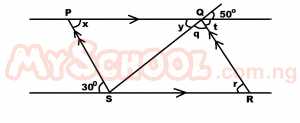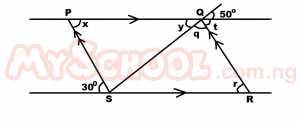Year :
2007
Title :
Mathematics (Core)
Exam :
JAMB Exam
Paper 1 | Objectives
31 - 40 of 47 Questions
| # | Question | Ans |
|---|---|---|
| 31. |
Given A. P∩Q = ∅ B. P ⊂ Q C. Q⊂P D. P = Q Detailed SolutionP = {1, 3, 5, 7, 9, 11}Q = {2, 4, 6, 8, 1, 12} P∩Q = {1, 3, 5, 7, 9, 11}∩{2, 4, 6, 8, 1, 12} = {} = ∅ |
|
| 32. |
Evaluate 101122 - 10122 A. 1100002 B. 1102 C. 11000002 D. 110002 Detailed Solution101122 - 10122 = (1x23 + 0x22 + 1x21 + 1x20)2 - (1x22 + 0x21 + 1x22)2(1x8 + 0x4 + 1x2 + 1x1) 2 - (1x4 + 0x2 + 1x1) 2) = (8 + 0 + 2 + 1) 2 - (4 + 0 + 1) 2 = 112 - 52 = 16 x 6 = 96 9610 to base 2 2/96 = 48 R 0 2/48 = |
|
| 33. |
If X = {all the perfect squares less than 40} A. {3, 9} B. {9} C. {9, 25} D. {1, 9} Detailed SolutionAll the perfect squares < 40X = {1, 4, 9, 16, 25, 36} All the odd numbers from 1 to 15 Y = {1, 3, 5, 7, 9, 11, 13, 15} X ∩ Y = {1, 9} |
|
| 34. |
Calculate the length of an arc of a circle diameter 14 cm, which substends an angle of 90o at the center of the circle A. 7π/2 cm B. 7π cm C. 14π cm D. 7π/4 cm Detailed SolutionLength of an arc = θ/360 x 2πr90/360 x 2 x π x 7 = 7π/2 |
|
| 35. |
If the lines 3y = 4x - 1 and qy = x + 3 are parallel to each other, the value of q is A. -4/3 B. -3/4 C. 4/3 D. 3/4 Detailed SolutionIf the line 3y = 4x – 1 is parallel t[ line qy = x + 3Implies gradient of 3y = 4x – 1 Y = 4/3x - 1/3 ∴Gradient = 4/3 Gradient of line qy = x + 3 Y = 1/qx + 3/q ∴ Gradient = 1/q 4/3 = 1/q 4q = 3 Q = 3/4 |
|
| 36. |
 In the parallelogram PQRS above, find angle SQR A. 100o B. 80o C. 50o D. 30o Detailed Solution
 Y = 50o (vertical opposite ∠s) r = 30o (alternate ∠s b/c PQ//SR) But = y + q + t = 180o (∠s on a straight line) 50 + q + 30 = 180 q + 80 = 180 q = 180 -80 q = 100o |
|
| 37. |
The volume of a hemispherical bowl is \(718\frac{2}{3}\). Find its radius . A. 4.0 cm B. 5.6 cm C. 7.0 cm D. 3.8 cm Detailed SolutionVolume of bowl \(\frac{2}{3}\pi r^2\\718\frac{2}{3}=\frac{2}{3}\pi r^2\\ \frac{2156}{3}=\frac{2}{3} \times \frac{22}{7} \times r^3 ∴r^3 = \frac{2156 \times 3 \times 7}{3 \times 2 \times 22}\\ r^3 = 343\\ r = \sqrt[3]{343}\\ r= 7.0cm\) |
|
| 38. |
A particle P moves between points S and T such that angles SPT is always constant of ST constant. Find the locus of P A. It is a semi circle with ST as diameter B. It is a perpendicular bisector of St C. It is a quadrant of a circle with ST as diameter D. It is a straight line perpendicular to ST |
A |
| 39. |
If the lines 2y - kx + 2 = 0 and y + x - k/2 = 0 Intersect at (1, -2), find the value of k A. -4 B. -3 C. -2 D. -1 Detailed SolutionIf the point of intersection is (1, -2), it implies that x = 1 and y = -2 when the two equation are solved simultaneously.∴ substitute x = 1 and y = -2 in any of the equations 2y - k x + 2 = 0 2(-2) - k(1) + 2 = 0 -4 - k + 2 = 0 -4 + 2 = k -2 = k |
|
| 40. |
A man 40 m from the foot of a tower observes the angle of elevation of the tower to be 30o. Determine the height of the tower. A. \(\frac{40\sqrt{3}}{3}m\) B. 20 m C. 40√3 m D. 40 m Detailed Solution
 \frac{1}{\sqrt{3}}=\frac{h}{40}\\ h\sqrt{3}=40\\ h = \frac{40}{\sqrt{3}}\\ h = \frac{40}{\sqrt{3}} \times \frac{\sqrt{3}}{\sqrt{3}}\\ h = \frac{40\sqrt{3}}{3}\) |
| 31. |
Given A. P∩Q = ∅ B. P ⊂ Q C. Q⊂P D. P = Q Detailed SolutionP = {1, 3, 5, 7, 9, 11}Q = {2, 4, 6, 8, 1, 12} P∩Q = {1, 3, 5, 7, 9, 11}∩{2, 4, 6, 8, 1, 12} = {} = ∅ |
|
| 32. |
Evaluate 101122 - 10122 A. 1100002 B. 1102 C. 11000002 D. 110002 Detailed Solution101122 - 10122 = (1x23 + 0x22 + 1x21 + 1x20)2 - (1x22 + 0x21 + 1x22)2(1x8 + 0x4 + 1x2 + 1x1) 2 - (1x4 + 0x2 + 1x1) 2) = (8 + 0 + 2 + 1) 2 - (4 + 0 + 1) 2 = 112 - 52 = 16 x 6 = 96 9610 to base 2 2/96 = 48 R 0 2/48 = |
|
| 33. |
If X = {all the perfect squares less than 40} A. {3, 9} B. {9} C. {9, 25} D. {1, 9} Detailed SolutionAll the perfect squares < 40X = {1, 4, 9, 16, 25, 36} All the odd numbers from 1 to 15 Y = {1, 3, 5, 7, 9, 11, 13, 15} X ∩ Y = {1, 9} |
|
| 34. |
Calculate the length of an arc of a circle diameter 14 cm, which substends an angle of 90o at the center of the circle A. 7π/2 cm B. 7π cm C. 14π cm D. 7π/4 cm Detailed SolutionLength of an arc = θ/360 x 2πr90/360 x 2 x π x 7 = 7π/2 |
|
| 35. |
If the lines 3y = 4x - 1 and qy = x + 3 are parallel to each other, the value of q is A. -4/3 B. -3/4 C. 4/3 D. 3/4 Detailed SolutionIf the line 3y = 4x – 1 is parallel t[ line qy = x + 3Implies gradient of 3y = 4x – 1 Y = 4/3x - 1/3 ∴Gradient = 4/3 Gradient of line qy = x + 3 Y = 1/qx + 3/q ∴ Gradient = 1/q 4/3 = 1/q 4q = 3 Q = 3/4 |
| 36. |
 In the parallelogram PQRS above, find angle SQR A. 100o B. 80o C. 50o D. 30o Detailed Solution
 Y = 50o (vertical opposite ∠s) r = 30o (alternate ∠s b/c PQ//SR) But = y + q + t = 180o (∠s on a straight line) 50 + q + 30 = 180 q + 80 = 180 q = 180 -80 q = 100o |
|
| 37. |
The volume of a hemispherical bowl is \(718\frac{2}{3}\). Find its radius . A. 4.0 cm B. 5.6 cm C. 7.0 cm D. 3.8 cm Detailed SolutionVolume of bowl \(\frac{2}{3}\pi r^2\\718\frac{2}{3}=\frac{2}{3}\pi r^2\\ \frac{2156}{3}=\frac{2}{3} \times \frac{22}{7} \times r^3 ∴r^3 = \frac{2156 \times 3 \times 7}{3 \times 2 \times 22}\\ r^3 = 343\\ r = \sqrt[3]{343}\\ r= 7.0cm\) |
|
| 38. |
A particle P moves between points S and T such that angles SPT is always constant of ST constant. Find the locus of P A. It is a semi circle with ST as diameter B. It is a perpendicular bisector of St C. It is a quadrant of a circle with ST as diameter D. It is a straight line perpendicular to ST |
A |
| 39. |
If the lines 2y - kx + 2 = 0 and y + x - k/2 = 0 Intersect at (1, -2), find the value of k A. -4 B. -3 C. -2 D. -1 Detailed SolutionIf the point of intersection is (1, -2), it implies that x = 1 and y = -2 when the two equation are solved simultaneously.∴ substitute x = 1 and y = -2 in any of the equations 2y - k x + 2 = 0 2(-2) - k(1) + 2 = 0 -4 - k + 2 = 0 -4 + 2 = k -2 = k |
|
| 40. |
A man 40 m from the foot of a tower observes the angle of elevation of the tower to be 30o. Determine the height of the tower. A. \(\frac{40\sqrt{3}}{3}m\) B. 20 m C. 40√3 m D. 40 m Detailed Solution
 \frac{1}{\sqrt{3}}=\frac{h}{40}\\ h\sqrt{3}=40\\ h = \frac{40}{\sqrt{3}}\\ h = \frac{40}{\sqrt{3}} \times \frac{\sqrt{3}}{\sqrt{3}}\\ h = \frac{40\sqrt{3}}{3}\) |

